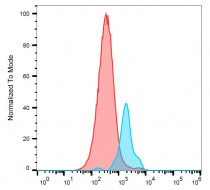ARG42295
anti-Nectin 1 antibody [R1.302] (PE)
anti-Nectin 1 antibody [R1.302] (PE) for Flow cytometry and Human
Overview
| Product Description | PE-conjugated Mouse Monoclonal antibody [R1.302] recognizes Nectin 1 |
|---|---|
| Tested Reactivity | Hu |
| Tested Application | FACS |
| Specificity | The mouse monoclonal antibody R1.302 recognizes an extracellular epitope on CD111 (also known as Nectin 1), a 75 kDa type I transmembrane glycoprotein broadly expressed on endothelial cells, epithelial cells, neuronal cells, megakaryocytes, and CD34-positive stem cells. |
| Host | Mouse |
| Clonality | Monoclonal |
| Clone | R1.302 |
| Isotype | IgG1, kappa |
| Target Name | Nectin 1 |
| Antigen Species | Human |
| Immunogen | NIH/3T3 cells transfected with Human Nectin 1. |
| Conjugation | PE |
| Alternate Names | HveC; nectin-1; PVRR1; PVRR; HV1S; Nectin-1; PRR1; HIgR; SK-12; CD111; CD antigen CD111; Herpesvirus Ig-like receptor; CLPED1; OFC7; ED4; PRR; Herpes virus entry mediator C; Herpesvirus entry mediator C; Poliovirus receptor-related protein 1; HVEC |
Application Instructions
| Application Suggestion |
|
||||
|---|---|---|---|---|---|
| Application Note | * The dilutions indicate recommended starting dilutions and the optimal dilutions or concentrations should be determined by the scientist. |
Properties
| Form | Liquid |
|---|---|
| Purification | Purified |
| Buffer | PBS and 15 mM Sodium azide. |
| Preservative | 15 mM Sodium azide |
| Storage Instruction | Aliquot and store in the dark at 2-8°C. Keep protected from prolonged exposure to light. Avoid repeated freeze/thaw cycles. Suggest spin the vial prior to opening. The antibody solution should be gently mixed before use. |
| Note | For laboratory research only, not for drug, diagnostic or other use. |
Bioinformation
| Database Links | |
|---|---|
| Gene Symbol | PVRL1 |
| Gene Full Name | poliovirus receptor-related 1 (herpesvirus entry mediator C) |
| Background | This gene encodes an adhesion protein that plays a role in the organization of adherens junctions and tight junctions in epithelial and endothelial cells. The protein is a calcium(2+)-independent cell-cell adhesion molecule that belongs to the immunoglobulin superfamily and has 3 extracellular immunoglobulin-like loops, a single transmembrane domain (in some isoforms), and a cytoplasmic region. This protein acts as a receptor for glycoprotein D (gD) of herpes simplex viruses 1 and 2 (HSV-1, HSV-2), and pseudorabies virus (PRV) and mediates viral entry into epithelial and neuronal cells. Mutations in this gene cause cleft lip and palate/ectodermal dysplasia 1 syndrome (CLPED1) as well as non-syndromic cleft lip with or without cleft palate (CL/P). Alternative splicing results in multiple transcript variants encoding proteins with distinct C-termini. [provided by RefSeq, Oct 2009] |
| Function | Promotes cell-cell contacts by forming homophilic or heterophilic trans-dimers. Heterophilic interactions have been detected between NECTIN1 and NECTIN3 and between NECTIN1 and NECTIN4. Has some neurite outgrowth-promoting activity. (Microbial infection) Acts as a receptor for herpes simplex virus 1/HHV-1, herpes simplex virus 2/HHV-2, and pseudorabies virus/PRV. [UniProt] |
| Cellular Localization | Isoform Alpha: Cell membrane; Single-pass type I membrane protein. Cell junction, synapse, presynaptic cell membrane. Isoform Delta: Cell membrane; Single-pass type I membrane protein. Isoform Gamma: Secreted. [UniProt] |
| Calculated MW | 57 kDa |
Images (1) Click the Picture to Zoom In






